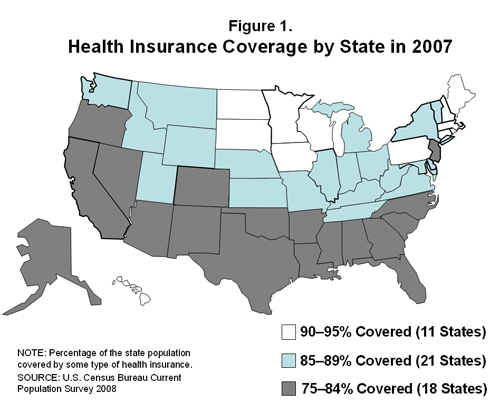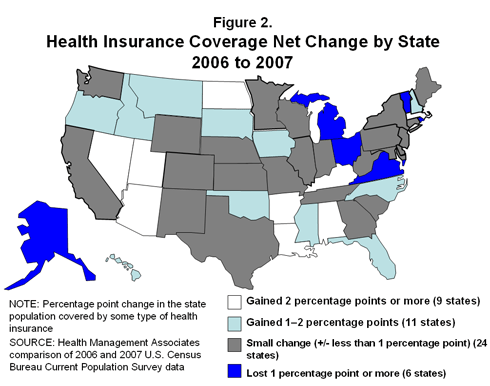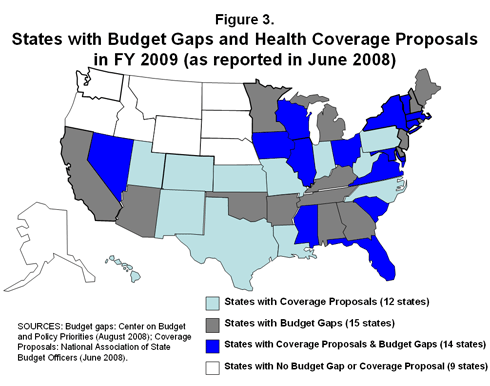| Please take a moment to answer this short survey to help us improve the States in Action newsletter. We appreciate and welcome your feedback. |
The U.S. Census Bureau reported recently that both the percentage and number of people without health insurance decreased in 2007, from 47.0 million (15.8 percent) in 2006 to 45.7 million (15.3 percent) in 2007. The percentage of people covered by private health insurance actually decreased, but the drop in private coverage was more than offset by an increase in coverage through government health insurance programs.
Meanwhile, the economy took a turn for the worse, threatening to undo gains in health insurance coverage and straining state budgets. Even before the Wall Street financial crisis, the Center for Budget and Policy Priorities reported that 29 states were facing budget shortfalls in 2009, raising serious doubts about their ability to sustain gains in health coverage or consider additional reforms.
This issue of States in Action takes a close look at the Census Bureau's health insurance coverage data, considering how coverage changed by state, and describes ways in which states are trying to stay the course to cover the uninsured in a worsening economy.
Extent and Source of Coverage Vary by State
In 2007, 84.7 percent of the U.S. population was covered by some type of health insurance. But national statistics mask great differences in rates and sources of coverage from state to state; some states have much further to go to close gaps in coverage. Among the states, coverage rates ranged from 74.9 percent to 94.6 percent, with the highest rates in the Northeast and Upper Midwest and the lowest rates in the South and Southwest (Figure 1). States with large populations, including California, Florida, Georgia, North Carolina, and Texas, tend to have coverage rates below the national average. Among the 10 largest states, only Pennsylvania covers more than 90 percent of its population. Among the 15 smallest states, only Alaska's coverage rate (81.7 percent) is less than the national average.

Sources of coverage also vary considerably across states. For example, the percentage of people covered by employer-based and individually purchased private insurance ranges from lows of 56 to 57 percent in Texas, Mississippi, and New Mexico to highs of 78 to 80 percent in Minnesota, New Hampshire, North Dakota, and Iowa. Medicaid covers less than 7 percent of the population in New Hampshire and Nevada and more than 20 percent in Mississippi and the District of Columbia.
Some Coverage Gains, Some Losses
Across the nation, increases in health insurance premiums are outpacing wage growth, causing some employers to scale back benefits, require greater cost sharing by employees, or drop coverage altogether. Employer-sponsored health coverage dropped from 59.7 percent in 2006 to 59.3 percent in 2007. In 2007, this loss of employer-based coverage was more than offset by gains in government health insurance programs, including Medicare, Tricare, and, most important, Medicaid. Medicaid alone added 1.3 million people to its rolls in 2007. As a result, the percentage of people with some type of health insurance in the U.S. increased from 84.2 percent in 2006 to 84.7 in 2007.
After seven years of steady increases in the number of uninsured Americans, coverage gains in 2007 were widely reported as good news. But not all states shared in the gains: in 20 states, there were significant increases in the percentage of the population covered by some type of health insurance, while in six states there were significant coverage losses (Figure 2).

Within states, the interplay between private coverage and Medicaid was important. In 2007, additions to Medicaid rolls offset private coverage losses in 18 states. In 15 states the reverse was true: private coverage expanded and Medicaid enrollment fell. These trends suggest that Medicaid is functioning as intended, responding to economic conditions state by state and entitling more citizens to enroll as personal income drops during an economic downturn. In this way, the program minimizes the effects of economic downturns on the overall coverage rate.
Medicaid Fills Gaps Left by Declining Private Coverage
Following the economic downturn of 2001 to 2004, state revenues grew 8.9 percent in 2005 and 2006, significantly above the historical average of 6.7 percent.[1] The boost in revenues enabled many states to expand public health insurance programs, resulting in the increased coverage rates seen in 2007 that helped to offset drops in private coverage. States implemented an array of changes to Medicaid programs, including: increasing provider payment rates, expanding eligibility and simplifying enrollment processes, improving or restoring targeted benefits, and expanding community-based long-term care.[2]
Medicaid directors did not take the upturn in state revenue for granted. While pursing coverage expansions, they also aimed to control spending growth, honing strategies that held Medicaid cost growth to a record low of 1.3 percent in 2006. In light of the current economic downturn, their caution was clearly warranted. The National Association of State Budget Officers began warning states in 2007 that "the housing market downturn could lead to slowing revenue growth in the near future."[3]
Despite Budget Restraints, States Aim to Cover Uninsured
Much has changed since the 2007 Census data were collected. In just the past six weeks, the economy has worsened on a scale not seen in a lifetime. Even before the bottom fell out of the U.S. housing and credit markets, state budget officials were predicting only a 1 percent increase in overall state general fund spending for fiscal 2009—the third lowest spending increase in the past 31 years.[4] According to the Center for Budget and Policy Priorities, revenues are expected to fall short of proposed spending in 29 states in 2009 (Figure 3). Medicaid directors in two-thirds of states report that there is at least a 50 percent likelihood of a Medicaid budget shortfall in their state in 2009.[5]
Despite budget challenges, more than half of the states have enacted plans to increase coverage for the uninsured in 2009 (Figure 3). Governors' plans vary, from proposals to cover all of the uninsured to targeted expansions for specific groups such as uninsured children and small business employees. Most state plans to reduce the number of uninsured use Medicaid as a building block for additional coverage and financing. All of the coverage expansion proposals were enacted prior to the credit crunch—before states understood how difficult it would be for them to issue bonds to cover spending until personal income tax revenues are collected next spring; and before they revised their 2009 revenue estimates downward to reflect the worsening economy.

"States want to stay on course with coverage reforms," says Anne Kohler, director of the National Association of State Medicaid Directors, "but the sudden inability to borrow or meet revenue projections, and concerns about employee pension programs, create a perfect storm of budget challenges—this is happening now, and it's not yet clear which states will be in a position to expand coverage."
Conclusion
The good news about the decreased number of uninsured Americans in 2007 was quickly overshadowed by the worsening economy. Yet, covering the uninsured remains a high priority and has bipartisan support across many state governments. Many states hope to leverage their Medicaid programs to fill gaps in coverage resulting from the continued erosion of private coverage. However, the current economic crisis will test the resolve of governors and legislators who want to sustain recent coverage gains and further expand coverage to the 47 million Americans who are still uninsured.
|
[1] National Association of State Budget Officers (NASBO) and National Governors Association (NGA), "The Fiscal Survey of States," June 2008.
[2] V. Smith et al., Headed for a Crunch: An Update on Medicaid Spending, Coverage and Policy Heading into an Economic Downturn, Results from a 50-State Medicaid Budget Survey for State Fiscal Years 2008 and 2009, Kaiser Commission on Medicaid and the Uninsured, September 2008.
[3] NASBO and NGA, "The Fiscal Survey of States," June 2007.
[4] NASBO and NGA, "The Fiscal Survey of States," June 2008.
[5] V. Smith et al., September 2008.


